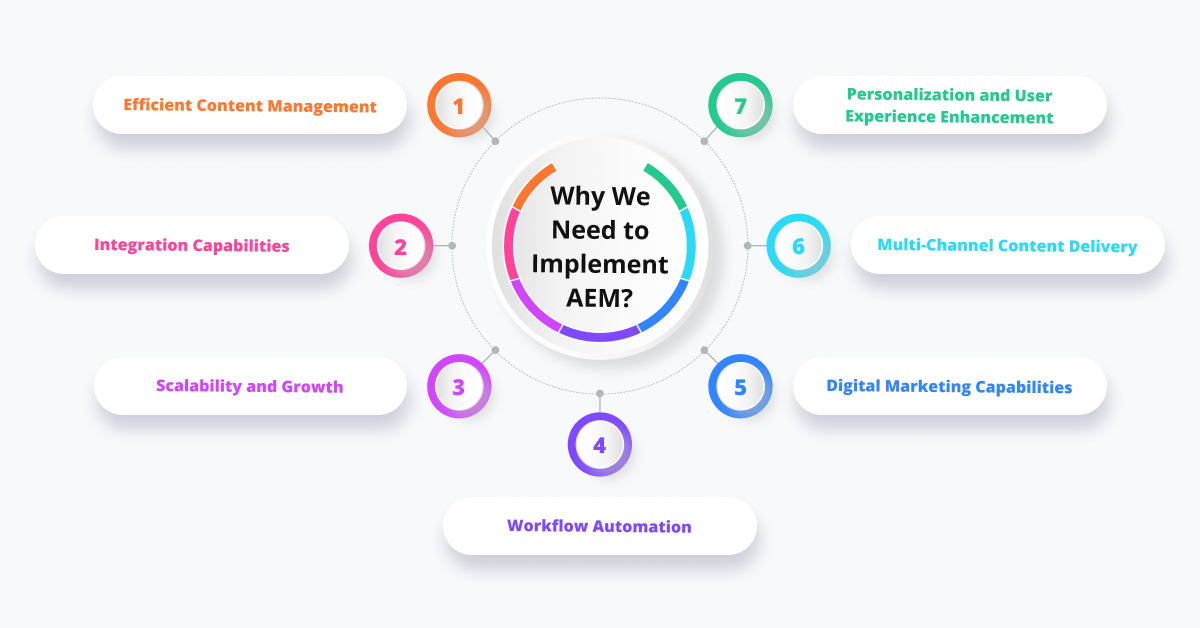
6 Key Factors for Successful AEM Implementation
-
By Shamsher Singh Bhullar
-
28th September 2023
Adobe Experience Manager (AEM) is a powerful content management solution trusted by businesses worldwide. However, a successful AEM implementation isn’t just about deploying the software; it’s about maximizing its capabilities to create seamless digital experiences. The AEM implementation process involves checking up on website infrastructure, architecture, organization, UI/UX design, and function. Streamlining these processes is crucial for the successful implementation of AEM.
As someone with extensive experience in AEM implementation services, we’ll share six critical factors to ensure a successful AEM implementation. We’ll also touch upon AEM migration and why Adobe Experience Manager services are essential in this journey.
Before shedding light on key factors, let’s discuss the AEM implementation and why we must implement it. So, without wasting much time, grab a cup of coffee in your hand and brace yourself to read this guide.
What is AEM Implementation?
Adobe Experience Manager implementation is the process of moving the Content Management System (CMS) to AEM with the help of various tools to make the code and content ready. AEM is one of the most heavyweight champions in content and digital asset management. It allows users to create personalized experiences for customers. Once the AEM environment is implemented, you can manage your digital assets from a central repository and function seamlessly as an enterprise.
Best suited for large-scale business organizations, AEM is a CMS and digital asset management tool that aims to offer long-term business success.
Why We Need to Implement AEM?

Implementing Adobe Experience Manager (AEM) is essential for businesses seeking efficient content management and enhanced user experiences. AEM streamlines content workflows, making content creation and management more effective. It also facilitates highly personalized user experiences by analyzing user data and delivering tailored content. AEM’s multi-channel delivery ensures content is optimized for various devices and platforms. Certainly, let’s delve into the details of why organizations need to implement Adobe Experience Manager (AEM):
Efficient Content Management:
AEM offers a comprehensive suite of tools for content creation, management, and publishing. With its user-friendly interface, teams can easily collaborate on content projects, streamline workflows, and ensure content consistency. AEM’s central repository allows for the organized storage and retrieval of digital assets, making it simple to manage a large volume of content. This efficiency in content management reduces manual effort, minimizes errors, and accelerates time-to-market for new content.
Personalization and User Experience Enhancement:
AEM empowers organizations to deliver highly personalized experiences to their audience. By collecting and analyzing user data, AEM can create user profiles and target content based on individual preferences, behaviors, and demographics. This level of personalization enhances user engagement, drives conversion rates, and fosters brand loyalty. AEM’s ability to adapt content for various devices and screen sizes ensures a consistent and optimized experience across web, mobile, and other platforms.
Multi-Channel Content Delivery:
In today’s digital landscape, users access content through various channels, including websites, mobile apps, social media, and IoT devices. AEM is designed to support multi-channel content delivery, ensuring that content is responsive and performs optimally across diverse platforms. This capability allows organizations to reach a broader audience and remain competitive in an increasingly interconnected digital world.
Digital Marketing Capabilities:
AEM integrates powerful digital marketing tools, enabling organizations to create, manage, and analyze marketing campaigns seamlessly. Marketers can design engaging landing pages, execute email marketing campaigns, and track user interactions with precision. AEM’s analytics and reporting features provide valuable insights into campaign performance, allowing marketers to refine strategies and improve ROI.
Workflow Automation:
AEM automates content approval workflows, reducing manual intervention and the risk of human errors. Teams can establish customized workflows that govern content creation, editing, review, and publication. Automated notifications and reminders ensure that content progresses through the approval process efficiently. This automation enhances content consistency, reduces bottlenecks, and ensures compliance with organizational guidelines.
Scalability and Growth:
AEM is built to scale with the growth of an organization. It can handle increasing content volumes, user traffic, and digital assets without compromising performance. This scalability is crucial for businesses aiming to expand their digital presence and accommodate growing audience demands. AEM’s flexibility allows organizations to adapt to changing market dynamics and evolving customer expectations.
Integration Capabilities:
AEM is known for its robust integration capabilities. It can seamlessly integrate with other Adobe products, such as Adobe Analytics and Adobe Target, to create a unified digital ecosystem. Additionally, AEM supports third-party integrations, enabling organizations to connect with CRM systems, e-commerce platforms, social media networks, and more. This integration prowess streamlines data sharing, enhances marketing capabilities, and provides a comprehensive view of user interactions.
The implementation of Adobe Experience Manager (AEM) is vital for organizations seeking to streamline content management, enhance user experiences, and stay competitive in the digital age.
6 Key Factors for Successful AEM Implementation
Successful Adobe Experience Manager (AEM) implementation is critical for organizations looking to leverage this robust platform effectively. Here are six key factors that contribute to a successful AEM implementation:

1. Comprehensive Planning and Strategy
A successful AEM implementation begins with a well-defined strategy. You need to understand your organization’s goals, target audience, and content requirements thoroughly. It’s essential to involve key stakeholders and departments to align on objectives and expectations.
Start by conducting a detailed content audit and create a roadmap that outlines the implementation phases. This roadmap should encompass content migration, template and component development, and integration with other systems.
Adobe Experience Manager services come into play here. Expert consultants can help you craft a robust strategy that ensures AEM aligns with your long-term business objectives.
2. User-Centric Design and Development
AEM is known for its flexibility in creating dynamic web experiences. However, it’s crucial to focus on user experience (UX) during design and development. Utilize AEM’s responsive design capabilities to deliver content seamlessly across different devices.
Leverage AEM’s component-based architecture to create reusable building blocks for your website or application. This approach streamlines development, reduces redundancy, and ensures consistency.
3. Content Migration Strategy
Migrating content from your old system to AEM can be complex. It’s vital to have a well-thought-out content migration strategy in place. Consider the following:
a.) Identify critical content: Prioritize content that drives business value.
b.) Content mapping: Map old content structures to AEM’s content hierarchy.
c.) Data cleansing: Cleanse and validate data during migration to maintain data integrity.
d.) Automated migration tools: Utilize AEM’s migration tools or third-party solutions for efficiency. Adobe Experience Manager services often include migration experts who can guide you through this process seamlessly.
4. Integration with Existing Systems
AEM doesn’t operate in isolation. Successful AEM implementations involve integrating AEM with other systems such as Customer Relationship Management (CRM), e-commerce platforms, and third-party services.
AEM provides robust integration capabilities through APIs and connectors. Adobe Experience Manager services can assist in designing and implementing these integrations to ensure seamless data flow and functionality across your technology stack.
5. Scalability and Performance Optimization
As your digital presence grows, scalability becomes crucial. Your AEM implementation should be designed to handle increasing traffic, content, and user interactions without compromising performance.
Implement best practices for caching, content delivery networks (CDNs), and load balancing. Continuously monitor system performance and make necessary adjustments. It is also crucial to experience highly available and robust AEM infrastructure. All thanks to the DevOps and its ultimate power. With the help of IT teams, you can efficiently build CI/CD pipelines with tools such as Jenkins. At the same time, you can handle the infrastructure efficiently.
6. Robust Training and Support
Your AEM implementation is only as good as the team managing it. Proper training is vital for your content authors, developers, and administrators to harness the full potential of AEM.
Consider investing in Adobe Experience Manager services for ongoing support and maintenance. This ensures that your implementation stays up-to-date, secure, and optimized for evolving business needs.
AEM Migration Guide
Migration to AEM from another content management system or an earlier version of AEM can be challenging. Read a brief AEM 6.4 to 6.5 migration guide to supplement your successful implementation.
Conclusion
In the world of digital experiences, a successful AEM implementation is a cornerstone of your online presence. By prioritizing comprehensive planning, user-centric design, content migration, integration, scalability, and ongoing support, you’ll set the stage for a successful AEM journey.
Remember that AEM migration can be complex but manageable with careful planning and execution. Adobe Experience Manager services, with their wealth of expertise, can significantly enhance your chances of success. Embrace AEM’s capabilities, and your organization will be well on its way to delivering outstanding digital experiences in 2024 and beyond.
FAQs
What is meant by AEM?
Adobe Experience Manager (AEM) is a content management and digital asset management tool that helps enterprises manage, distribute and optimize digital assets, such as videos, images, rich media, documents, forms, etc., from a central platform. You can create digital experiences for varied devices from a single platform and harness the power of content personalization. You can also create websites through the AEM platform.
What are AEM implementation best practices?
The best practices in AEM implementation include creating a solid strategy, learning about AEM development and integration, working on a pilot website, expanding resources using DevOps and CI/CD pipelines, creating an organized team with specific task allocation, hiring technology experts in UI/UX, Front-end and AEM component development, AEM DevOps and Production Support.
How long does it take to implement AEM successfully?
The timeline varies depending on the scope and complexity of the project but typically ranges from several months to a year.
Can AEM integrate with other marketing tools?
Yes, AEM offers robust integration capabilities, allowing seamless connections with various marketing and analytics tools.
Is AEM suitable for e-commerce websites?
AEM can be tailored for e-commerce websites, offering advanced features for product catalogs, shopping carts, and more.
Recent Articles
-

Unity vs Unreal Engine 5: Which is Better?
-

Non-Negotiable Tips for Developing a P2P Lending Platform
-

The 8 Leading Cross-Platform App Development Frameworks You Should Know
-

Step-by-Step Guide: How to Build a dApp on Ethereum with Ease
-

Why Does Your Business Need Blockchain Development Company’s Expertise?

Shamsher Singh Bhullar
 28th September 2023
28th September 2023